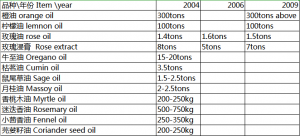
Production of essential oils in Europe
Hungary
In the 1970s, peppermint oil was Hungary’s largest oil producer, at one point reaching 180 tons.But because of strong competition from India, the country’s peppermint oil production has fallen to just a few tons.

Other less productive oils are fennel oil, carrot oil, Perilla oil, coriander oil, hops oil, bay oil, parsley oil, and vanilla oil.
Mint was mainly planted in Deaki and Zalavar, lavender was mainly planted in Tihany, oregano and tarragon were mainly planted in Kalocsa, and dill was mainly planted in Deaki and Dmsod.
In 2009, Hungary imported about 70 tons of essential oils.
Prior to 1990, essential oils produced in Romania were mainly used in the pharmaceutical and perfumery industries.Since the land reform act of 1990, much of the land used for essential oil production has been abandoned.Romania still produces pine oil, fir leaf oil, juniper seed oil, coriander oil, cumin oil and dill oil, but at a low yield
Statistic data show that Romania exported about 20 tons of essential oils in 2009, compared with 59 tons imported.
Romania has good traditional advantages in the synthesis of spices, and is a natural grade of synthetic spices, such as fusel oil and its derivatives, as well as the products separated from cedar oil.

Hessium oil is also under development with less oregano oil and less cumin oil and less thyme oil
Turkey imported 172 tons of orange oil and 59 tons of lemon oil in 2009, so its corresponding fresh fruit production is mainly for domestic consumption.
Rose oil: Damascus rose production in 7,000 to 8,000 tons, can produce 1.5 tons of rose oil and 7 tons of rose extract, the main production area is the province of ispalta.The production is mainly controlled by Gubirlik (about 30%), a provincial company. Biolandes and Robertet account for 50% of the total. The other 7% to 8% are produced by small and medium-sized processing companies.
Thyme oil (oregano and oregano) is grown in isparta, antalya, mersin and the Mediterranean coast, as well as laurel, sage and cumin seeds.
Benzoin: about 3 to 4 tons, collected from trees growing in the Mugla region along the west coast of the Mediterranean.
Around the Aegean sea, there are also hundreds of kilograms of sweet fennel seed oil, anise oil and cumin seed oil.
Table 13 production of main essential oils in Turkey

Moldova
Growing spices and medicinal plants is one of the most profitable parts of moldovan agriculture.
From 1980 to 1990, moldova was the largest producer of essential oils and medicinal plants in the former Soviet union: it produced 140 to 160 tons of essential oils annually, among which lavender oil, sage oil, mint oil, dill oil and rose oil accounted for about 35% of the total production of essential oils in the former Soviet union, and 3 to 5 thousand tons of medicinal flowers.Since the collapse of the Soviet union, the most valuable part of the ministry of agriculture has gone, too, because it has lost its market.The country’s output is now only 10% of its average between 1980 and 1990.
Ukraine
Around 2000, the country’s share of essential oil production was 40% for Perilla extract, 35% for lavender oil, 12% for absinthe, 6% for sage oil, and 4% for dill oil.Coriander oil is now the country’s largest producer of essential oils, despite high temperatures caused by severe droughts in 2007 and 2008
Table 14 oil export volume of Ukraine from 1998 to 2010 (unit: tons)

Slovakia
It mainly produces natural grade synthetic spices and a few essential oils.The country has only one distillery for essential oils, founded in 1998, and used to be a state-owned company.
Slovakia’s annual output of main essential oil (unit: kg/ year)
At its peak, mint oil reached 1,000 tons, ganuchi oil 270 tons, thyme oil 800 tons, and turpentine oil 580 tons.
But like other eastern European countries polish industry is in the midst of a structural and economic transformation.At present, it mainly produces fir oil, tarragon oil, European red pine oil and carrot seed oil.
In addition to these countries, there are other countries in Europe that are not included, such as Austria (which produces a lot of pine oil), Germany (which produces birch tar and chamomile oil), England (which produces lavender oil and peppermint oil), and Finland (which produces a lot of turpentine).At present, Europe’s total production of essential oils is 6,000 tons, accounting for about 6% of the global total production of essential oils.Many European countries that used to produce large amounts of essential oils have switched to finished products, such as cosmetics and pharmaceuticals, as well as cosmetics and fragrances.